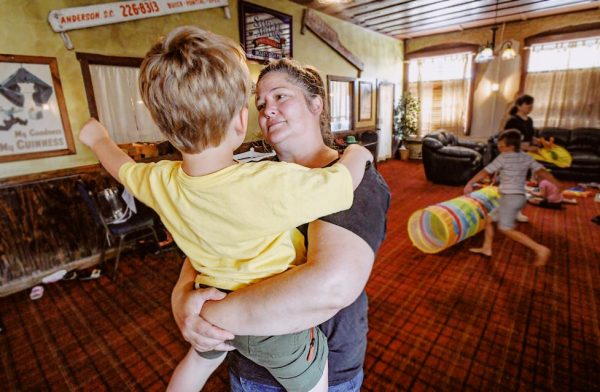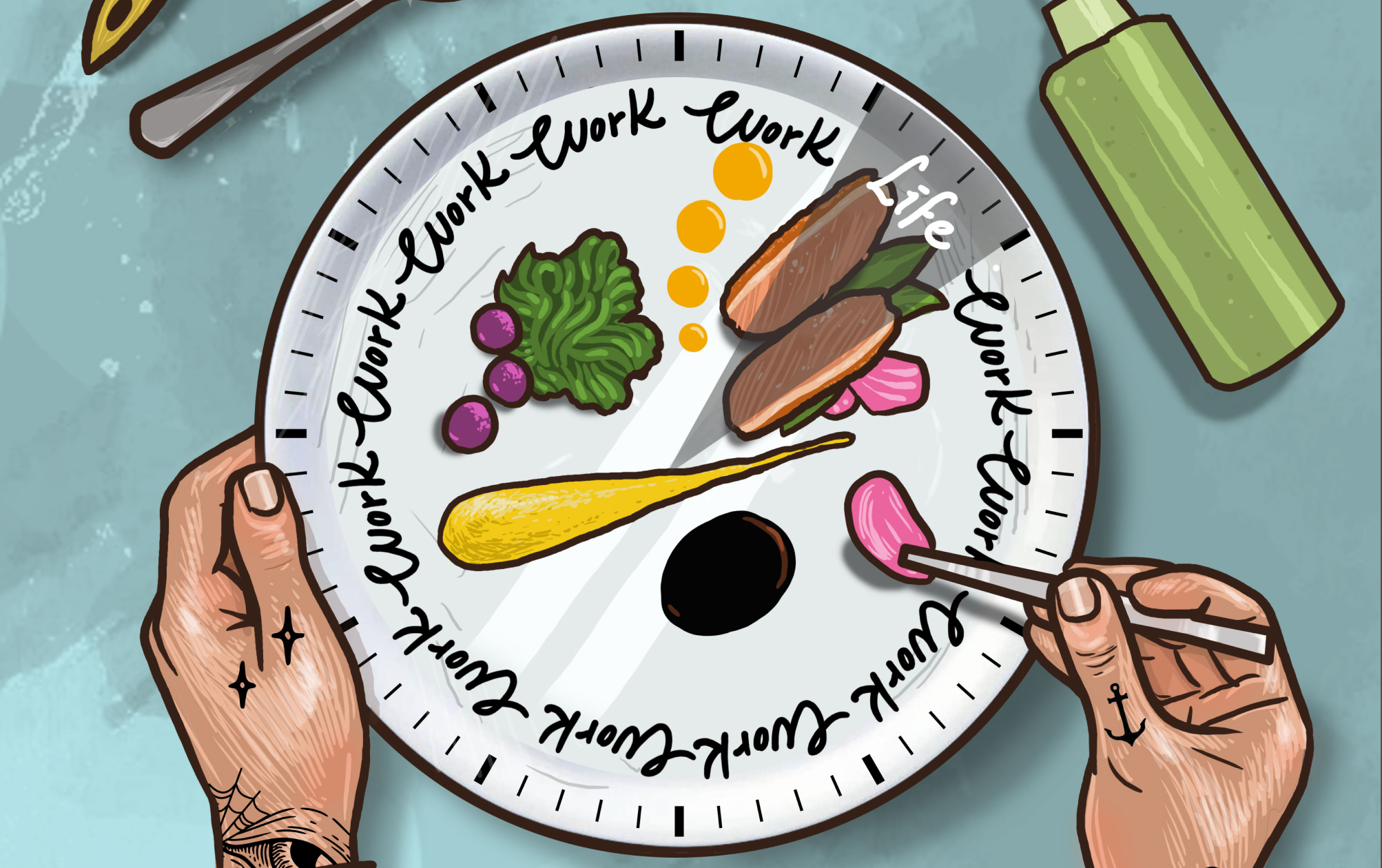The Childcare Conundrum
When McGee’s Scot Irish Pub in Anderson, South Carolina re-opened after the pandemic lockdown, chef and co-owner Dixie Benca found herself facing a new twist on an old problem. Her restaurant, which serves creative pub food, had been in business for more than 25 years, and during that time, she had seen her employees struggle to balance childcare with the late hours and unpredictable schedules of restaurant work—as had she and her husband, who works in the restaurant with her. But in those first months after lockdown, things had gotten much worse. While McGee’s might be open, daycare centers were not. And like every other restaurant in the world at the time, it was running perilously low on staff. When one of her employees got solo custody of his child and was suddenly faced with the prospect of no longer being able to work nights, Benca decided she had to do something. “People shouldn’t have to choose,” she says, “Between their family and having a job.”
And yet many feel like they do. Irregular schedules and working hours that stretch far outside 9 to 5 or Monday through Friday; low wages that make hiring caregivers an impossible extravagance; a lack of government support for the industry: all of these factors combine to make it inordinately difficult for chefs, servers, and bartenders to have a family. But at a time when the restaurant business as a whole is facing unprecedented labor shortages, addressing the childcare issue also presents a tremendous opportunity. Because as Dixie Benca found out when she implemented a creative solution, fixing that problem fixes a lot of other things as well.
The Childcare Gender Gap
That childcare still falls disproportionately to women helps explain why there are fewer in the profession (especially in its upper ranks) and contributes to why they earn less on average than their male counterparts. According to one British study, women hospitality workers in the UK are scheduled, on average, 19 hours fewer per month because of childcare demands—which translates to earning roughly £3500 less per year.
While she was working for Union Square Hospitality group in New York, Camilla Marcus, who would later go on to open the restaurant West-bourne, saw the effects again and again. “People would be in the management development pipeline but they wouldn’t be able to move ahead,” she recalls. “Their kid would have a health issue or their babysitter would quit, so there was no more childcare, and they couldn’t show up for work anymore. I was seeing the gender inequity firsthand, and seeing what a huge hurdle it was for career advancement.”
And regardless of the worker’s gender, the childcare problem contributes to difficulties in retaining restaurants have in retaining staff. The problem is especially acute in countries where daycare is not provided by the government. In the US, 18% of restaurant workers quit their jobs because of childcare issues last year. But even here in supposedly gender-equal Denmark, where daycare is heavily subsidized, it is not uncommon, when a couple who work in the industry have a child, for one partner to either move into an administrative role or leave the industry altogether.
“People shouldn’t have to choose between their family and having a job.”
Strong but Sparse Solutions
Expanded hours for daycare are one solution. In Denmark, as in other Scandinavian countries, most cities have at least one publicly funded center that is open nights and weekends. Ny Vartov in Copenhagen, for example, stays open 24 hours a day, every day of the year to help parents who work in a variety of fields with irregular hours, from healthcare and law enforcement to the performing arts and hospitality.
Parents who work evening shifts can pick their children up by 10pm or have them sleepover in one of the beds in the center’s homey, apartment-like setting. Like all daycare in the country, the service is heavily subsidized. And to get it, says Anne Henriksen, who heads the program, “the parents just have to show documentation that they work outside of normal hours.”
The low cost is key, because extended hours alone don’t solve the problem—childcare has to be affordable as well. In the United Kingdom, full-time childcare averages £15,000 a year, and although changes go into effect this month that add 15 hours of free care for children two and older, the median of families will see their childcare bill reduced only by £1200-1440. In parts of the US, daycare for an infant can average over $15,000. Add a second child in New York City, and the total can easily reach $28,000, or 98% of an entry-level server or cook’s salary.
Soon after she opened West-bourne, Camilla Marcus tried to solve for both the hours problem and the cost problem by taking matters into her own hands. “Hospitality is the second largest employer in the country, and the largest is healthcare, which has similar kinds of hours to restaurants. It got me thinking: the two biggest juggernauts in employment have the same dynamic, they don’t fit the 9-to-5 dynamic. How is this happening? There has to be a solution.”
She decided to create one of her own by partnering with a childcare start-up called Vivvi. The restaurant purchased a block of credits that could be used in any of Vivvi’s centers, then distributed those credits to employees who needed them—at no cost to the staff.
State and federal tax breaks helped West-bourne cover the expense. But Marcus points out that even without that assistance, the price of doing nothing would have been higher. “Replacing a team member who is at management level costs a lot of money. It’s much less expensive to provide the support services. When people asked me ‘How are you funding it?’, I would say, ‘You’re going to lose a lot more money if you lose that person you’ve trained up. You’re just not doing the math.”
At West-bourne, where roughly half of the 30-person team were parents, the childcare plan also had a less tangible impact. “Any parent who works in our industry knows that the systems are designed to make you feel like persona non grata. So, I think it meant something to them that our company was willing to do something about it. I think it made them feel seen.”

Camilla Marcus, Founder and CEO of West-bourne.
The Recipe for Employee Retention
That’s a lesson that Dixie Benca learned as well. She went further than Marcus: instead of working with an outside daycare company, McGee’s actually created its own right on the premises. They took a spare room they had on site, outfitted it with bean bags chairs, a tv, toys, and a changing table, and hired a couple of skilled babysitters to staff the room during service. They briefly considered charging staff members who used the childcare but decided instead to make it a perk of working for the restaurant. “As soon as we advertised it, we started getting applications like crazy,” Benca says. “It was after lockdown and everybody else was having a hard time finding staff. But we hired right up.”
McGee’s might have as many as six kids, ranging in age from two months to 12 years, in the daycare room (the relatively small number meant that they didn’t need to be formally licensed as a daycare facility in South Carolina, although rules vary in the US from state to state). Parents could stick their heads in whenever they had a moment, and could quickly deal with any minor dramas that occurred. When one child fell and bloodied his nose, for example, his mom was able quickly step away from the line, calm the boy down, and return to her station in a few minutes. “If that had happened offsite, she would have had to leave work for the rest of the shift,” says Benca.
But the program’s biggest boost came in holding on to employees. “Our retention rate was at 100% for at least a year,” Benca says. “We did not have one staff member leave. It drastically changed that thorn in our side, which was the turnover we had.”
Since they implemented the program, several of the original kids have aged out, and now McGee’s only brings in its sitters three or four nights a week. But the impact remains. “Our staff is so much more productive and happy,” Benca says. “Obviously a lot of them stay because of essentially free childcare, but I think they also feel that we really care about them and where they invest in their lives. So they’re probably more loyal to the restaurant in turn.”
“Yes, we choose to be in the industry, but we’re not machines.
We still deserve some kind of normalcy.”
When McGee’s first began its childcare program, it got a lot of attention from the media, and Benca hoped that other businesses would follow suit. She’s been gratified to learn that a new factory being built in her area will offer onsite childcare, and the local ambulance service is taking over an adjacent building in order to convert it into an extended-hours facility for its staff. But she’s been disappointed by the lack of response, both locally and further afield, from the hospitality industry. She hasn’t heard of a single restaurant that has adopted her method.
Why is that? Much of the problem is clearly structural, especially in countries without the public subsidies that make childcare affordable. While a growing number of private companies in other fields are beginning to either provide onsite childcare or subsidize their employees costs for it, restaurants— with their razor-thin (or nonexistent) profit margins—don’t really have the cushion.
That’s why Nuno Mendes, chef and owner of Lisboeta in London, thinks the government should be doing more. For most of his career, he paid for sitters so he could work nights, and there have been times when some of his team have volunteered to care for other staff members’ kids so they (the staff, not the kids) could work. But “it would be nice if there were government support to make that kind of change in a more established way,” Mendes says. “On their own, businesses would be hard squeezed to make the investment since the margins are getting tighter and tighter.”
Not all of the problem is strictly a matter of resources: some of it has to do with culture, and the good thing about culture is that it can change. We’ve seen this in recent years, as the hospitality industry has begun to provide health care and hiring human resource staff—common elements of other businesses that would have been unthinkable in restaurants even a decade ago.

Dixie Benca holds her son in the daycare room at McGee’s.
It wouldn’t take much beyond a spare room, a licensed childcare worker, and the willingness to do things differently for other restaurants to copy McGee’s model. Or even for a number of restaurants in a city or neighborhood to join forces and form their own childcare collective, open precisely during those same evening and weekend hours when their staff are actually working.
The rewards could be tremendous. In addition to making it easier to retain staff who are or who hope to become parents, that kind of benefit would allow more women to advance further in their careers. And by making it clear that choosing a career in hospitality does not necessarily mean choosing against having a family, the industry might actually find itself attracting more young talent.
“A lot of us like the work,” says Benca. “But the conditions have to change. Yes, we choose to be in the industry, but we’re not machines. We still deserve some kind of normalcy.”
–
Illustration by Sofie Kampmark




